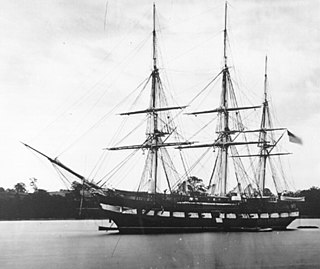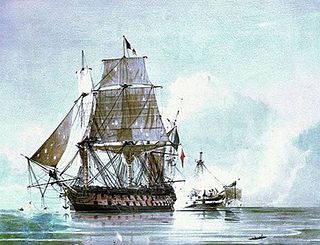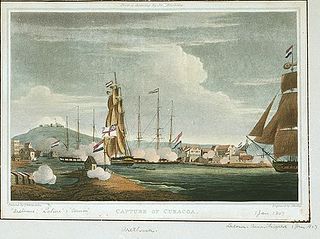
In the 18th century and most of the 19th, a sloop-of-war in the Royal Navy was a warship with a single gun deck that carried up to eighteen guns. The rating system covered all vessels with 20 guns and above; thus, the term sloop-of-war encompassed all the unrated combat vessels, including the very small gun-brigs and cutters. In technical terms, even the more specialised bomb vessels and fireships were classed as sloops-of-war, and in practice these were employed in the sloop role when not carrying out their specialised functions.
USS Maryland was a sloop-of-war in the United States Navy. She served during the Quasi-War with France.

HMS Leander was a Portland-class 50-gun fourth rate of the Royal Navy, launched at Chatham on 1 July 1780. She served on the West Coast of Africa, West Indies, and the Halifax station. During the French Revolutionary Wars she participated in the Battle of the Nile before a French ship captured her. The Russians and Turks recaptured her and returned her to the Royal Navy in 1799. On 23 February 1805, while on the Halifax station, Leander captured the French frigate Ville de Milan and recaptured her prize, HMS Cleopatra. On 25 April 1805, cannon fire from Leander killed an American seaman while Leander was trying to search an American vessel off the US coast for contraband. The resulting "Leander affair" contributed to the worsening of relations between the United States and Great Britain. In 1813, the Admiralty converted Leander to a hospital ship under the name Hygeia. Hygeia was sold in 1817.

HMS Arethusa was a 38-gun Minerva-class fifth-rate frigate of the Royal Navy built at Bristol in 1781. She served in three wars and made a number of notable captures before she was broken up in 1815.

HMS Anson was a ship of the Royal Navy, launched at Plymouth on 4 September 1781. Originally a 64-gun third rate ship of the line, she fought at the Battle of the Saintes.

Franchise was launched in 1798 as a 40-gun Coquille-class frigate of the French Navy. The British captured her in 1803 and took her into the Royal Navy under her existing name. In the war on commerce during the Napoleonic Wars she was more protector than prize-taker, capturing many small privateers but few commercial prizes. She was also at the battle of Copenhagen. She was broken up in 1815.
USS Portsmouth was constructed for the United States Navy in 1798 by master shipbuilder James Hackett to a design of Josiah Fox at what is now Badger's Island in Kittery, Maine, directly across the Piscataqua River from Portsmouth, New Hampshire. She was built with funds contributed by the citizens of Portsmouth.

HMS Juno was a Royal Navy 32-gun Amazon-class fifth rate. This frigate served during the American War of Independence, and the French Revolutionary and Napoleonic Wars.
HMS Hippomenes was a former Dutch corvette built in Vlissingen in 1797 for the Batavian Republic. The British captured her in 1803 and she served with the Royal Navy until sold in 1813. With the Royal Navy she participated in two notable single-ship actions in the West Indies.

HMS Surinam was a Cruizer-class brig-sloop built by Obadiah Ayles at Topsham, Exeter and launched in 1805. She captured one privateer during her twenty-year career and took part in two campaigns before she was broken up in 1825.
Three ships of the Royal Navy have borne the name HMS Surinam, after an English variation of Suriname:
HMS Surinam was the 18-gun Batavian corvette or sloop Pilades that the British captured on 5 May 1804 when they captured Surinam from the Dutch. The Batavian flotilla that the British captured was under the command of naval Captain Blots Van Treelong.
Four ships of the Royal Navy have either borne the name HMS Samarang or were intended to bear the name, after the port of Samarang, the site of HMS Psyche's capture of several Dutch vessels there in 1807.

HMS Halstarr was the Dutch frigate Kenau Hasselar, launched in 1800 that the British captured at Curaçao in 1807. The Royal Navy took her into service but the Admiralty sold her for breaking up in 1809.
The Dutch corvette Scipio was launched in 1784. She convoyed Dutch East Indiamen between the Cape of Good Hope and Europe until HMS Psyche captured her at Samarang in 1807. The British Royal Navy initially referred to her as HMS Scipio, but then renamed her to HMS Samarang in 1808. She was not commissioned in the Royal Navy. She was instrumental in the capture of Amboyna and especially Pulo Ay, and participated in the invasion of Java (1811). She was sold at Bombay in 1814. She then entered mercantile service, sailing between Liverpool and India until 1827. She became an opium trader sailing between India and Canton, and was broken up near Hong Kong in August 1833.
HMS Galgo was a Jamaican privateer that the Spanish Navy captured in 1797 and named Galgo Inglés, and that the British captured in November 1799. In her brief career she detained, took, or destroyed a number of small prizes before October 1800, when she foundered, with the loss of most of her crew and passengers.

HMS Rosario was a 20-gun sixth rate of the British Royal Navy. She was previously the French privateer Hardi, which HMS Anson captured in 1800. The navy took her into service as HMS Hardi but renamed her HMS Rosario later in 1800. She was sold in 1809.
Carron was launched at Bombay Dockyard in July 1792. She was a country ship that made several voyages for the British East India Company (EIC) before the Royal Navy purchased her in 1804 to use as a fifth-rate frigate, and renamed Duncan. In 1807 the Navy renamed her Dover. She was wrecked off Madras on 2 May 1811.

The invasion of the Spice Islands was a military invasion by British forces that took place between February and August 1810 on and around the Dutch owned Maluku Islands also known as the Spice Islands in the Dutch East Indies during the Napoleonic wars.
HMS Requin was the French Navy cutter Requin, launched at Boulogne in 1794. HMS Thalia captured Requin in 1795. Requin captured one small French privateer and participated in the capture of Suriname before wrecking in 1801.










